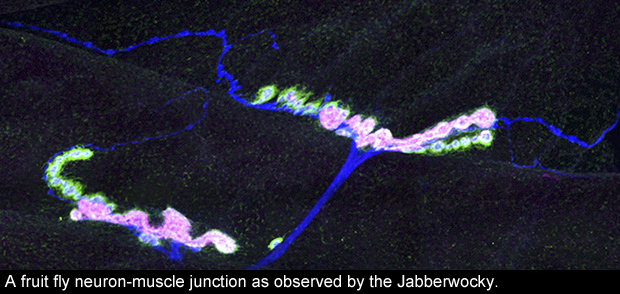Through the looking glass with biologist Avital Rodal
A state-of-the-art microscope nicknamed the Jabberwocky helps her unlock clues to the causes of ALS and other neurodegenerative diseases.

Meet the Jabberwocky.
It's a hulking microscope housed in its own room in the Rosenstiel Basic Medical Science Research Center. Assistant professor of biology Avital Rodal, whose lab is one of several using the device, gave it its nickname because of its monstrous size. Over the years, she's developed a habit of giving microscopes the names of mystical beasts. Others she's used have been called Smaug ("The Hobbit") and Toothless ("How To Train Your Dragon").
Rodal uses the Jabberwocky to peer inside the motor neurons of fruit fly larvae. She studies what are called nerve growth factors, which travel along nerve fibers to the nucleus carrying messages from muscle tissue. In neurodegenerative illnesses such as ALS and Alzheimer's, a growth factor's messages may not wind up being effectively communicated between neurons, triggering muscle cell dysfunction or death. A better understanding of why this miscommunication happens could lead to new drug treatments. (Click here for more on her research.)
Before Rodal examines her fly larva specimen in the Jabberwocky, she attaches genetic markers or tags to the growth factors she wants to see at work in the cell. The fly larva is alive, so that the cellular processes within it can be watched as they unfold.
The Jabberwocky then fires up to six lasers, one per fluorescent tag, so the tags illuminate in the sample. The fluorescent light is focused through a "spinning confocal disc," pocked with 10,000 pinholes arranged in a spiral. An ultrasensitive camera snaps pictures through the pinholes, which act as a super-precise sieve, removing out-of-focus light and allowing for a sharper focus. Light from an area of only a few hundred microns reaches the camera chip. The confocal disc spins so it can sweep across the specimen, taking pictures of the whole field of view of cellular components. The camera is powerful enough to capture the movement of a few photons of light. By moving the sample up and down incrementally, the Jabberwocky can capture 3D images as well.
All these images are stitched together into a super high definition view of the neuron by a computer. What makes the Jabberwocky so special is that it can illuminate several different tags at once, and record them moving relative to each other even though they might be buzzing around at speeds of up to several micrometers per second.
Rodal's ALS research is funded by a grant from the Blazeman Foundation for ALS Research.Rasmussen is a graduate student in the psychology program.
Categories: Science and Technology





